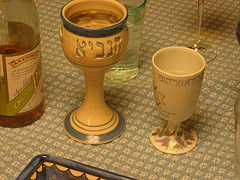The orange on the seder plate and Miriam's Cup: Foregrounding women at your seder
Just before we drink the second cup of wine in the Passover seder, we speak of three symbols considered indispensible to the holiday's meaning: the shank bone, the matzah, and the bitter herbs. However, in many homes, other symbols are added to this section, from the egg (which sits on the seder place but has no formal mention in traditional Haggadahs) to olives (signs of peace) to oranges and cups of water.
Last year, JewishBoston.com collaborated with the Jewish Women's Archive on a special edition of our Haggadah called "Including Women's Voices." Here's the section I wrote for that Haggadah on the customs and significance of the orange and Miriam's Cup.
The Orange
 Even after one has encountered the collection of seemingly unconnected foods on the seder plate year after year, it’s fun to ask what it’s all about. Since each item is supposed to spur discussion, it makes sense that adding something new has been one way to introduce contemporary issues to a seder.
Even after one has encountered the collection of seemingly unconnected foods on the seder plate year after year, it’s fun to ask what it’s all about. Since each item is supposed to spur discussion, it makes sense that adding something new has been one way to introduce contemporary issues to a seder.
So how was it that the orange found its place on the seder plate as a Passover symbol of feminism and women’s rights?
The most familiar version of the story features Susannah Heschel, daughter of Abraham Joshua Heschel and scholar in her own right, giving a speech about the ordination of women clergy. From the audience, a man declared, “A woman belongs on the bima like an orange belongs on the seder plate!” However, Heschel herself tells a different story.
During a visit to Oberlin College in the early 1980s, she read a feminist Haggadah that called for placing a piece of bread on the seder plate as a symbol of the need to include gays and lesbians in Jewish life. Heschel liked the idea of putting something new on the seder plate to represent suppressed voices, but she was uncomfortable with using chametz, which she felt would invalidate the very ritual it was meant to enhance. She chose instead to add an orange and to interpret it as a symbol of all marginalized populations. [Read more about the orange in this excerpt from Anita Diamant's Pitching My Tent.]
Miriam’s Cup
 A decade later, the ritual of Miriam’s Cup emerged as another way to honor women during the seder. Miriam’s Cup builds upon the message of the orange, transforming the seder into an empowering and inclusive experience.
A decade later, the ritual of Miriam’s Cup emerged as another way to honor women during the seder. Miriam’s Cup builds upon the message of the orange, transforming the seder into an empowering and inclusive experience.
Although Miriam, a prophet and the sister of Moses, is never mentioned in the traditional Haggadah text, she is one of the central figures in the Exodus story.
According to Jewish feminist writer Tamara Cohen, the practice of filling a goblet with water to symbolize Miriam’s inclusion in the seder originated at a Rosh Chodesh group in Boston in 1989. The idea resonated with many people and quickly spread.
Miriam has long been associated with water. The rabbis attribute to Miriam the well that traveled with the Israelites throughout their wandering in the desert. In the Book of Numbers, the well dries up immediately following Miriam’s death. Of course, water played a role in Miriam’s life from the first time we meet her, watching over the infant Moses on the Nile, through her triumphant crossing of the Red Sea.
There is no agreed-upon ritual for incorporating Miriam’s Cup into the seder, but there are three moments in the seder that work particularly well with Miriam’s story.
-
As Moses’s sister, Miriam protected him as an infant and made sure he was safely received by Pharaoh’s daughter. Some seders highlight this moment by invoking her name at the start of the Maggid section when we begin telling the Passover story.
-
Other seders, such as this one, incorporate Miriam’s cup when we sing songs of praise during the Maggid and later during the Hallel as a reminder that Miriam led the Israelites in song and dance during the Exodus.
- Still others place Miriam’s Cup alongside the cup we put out for Elijah.
Just as there is no set time in the seder to use Miriam’s Cup, there is no set ritual or liturgy either. Some fill the cup with water at the start of the seder; others fill the cup during the seder. Some sing Debbie Friedman’s “Miriam’s Song”; others sing “Miriam Ha-Neviah” by Rabbi Leila Gal Berner.
As with all seder symbols, Miriam’s Cup is most effective when it inspires discussion.
What does Miriam mean to you? How do all of her roles, as sister, protector, prophet, leader, singer, and dancer, contribute to our understanding of the Exodus story? Who are the Miriams of today?
Originally posted at JewishBoston.com, reposted with permission.
Miriam's Cup photo by Rabbi Rachel Barenblatt, used under a Creative Commons BY-SA-NC 2.0 license.






Regina Gradess contributed this comment to JWA: "We place a turnip on our seder plate as a reminder of the weak turnip soup that our family matriarch, my mother, Pearl Rosenzveig, survived on in Bergen Belsen concentration camp. She came out with pleurisy and loose teeth, but she recovered, thanks to Sweden's kindness. Her determination helped her live and make a new life for herself in America where she is now the grandmother of six and the great grandmother of one with one on the way."